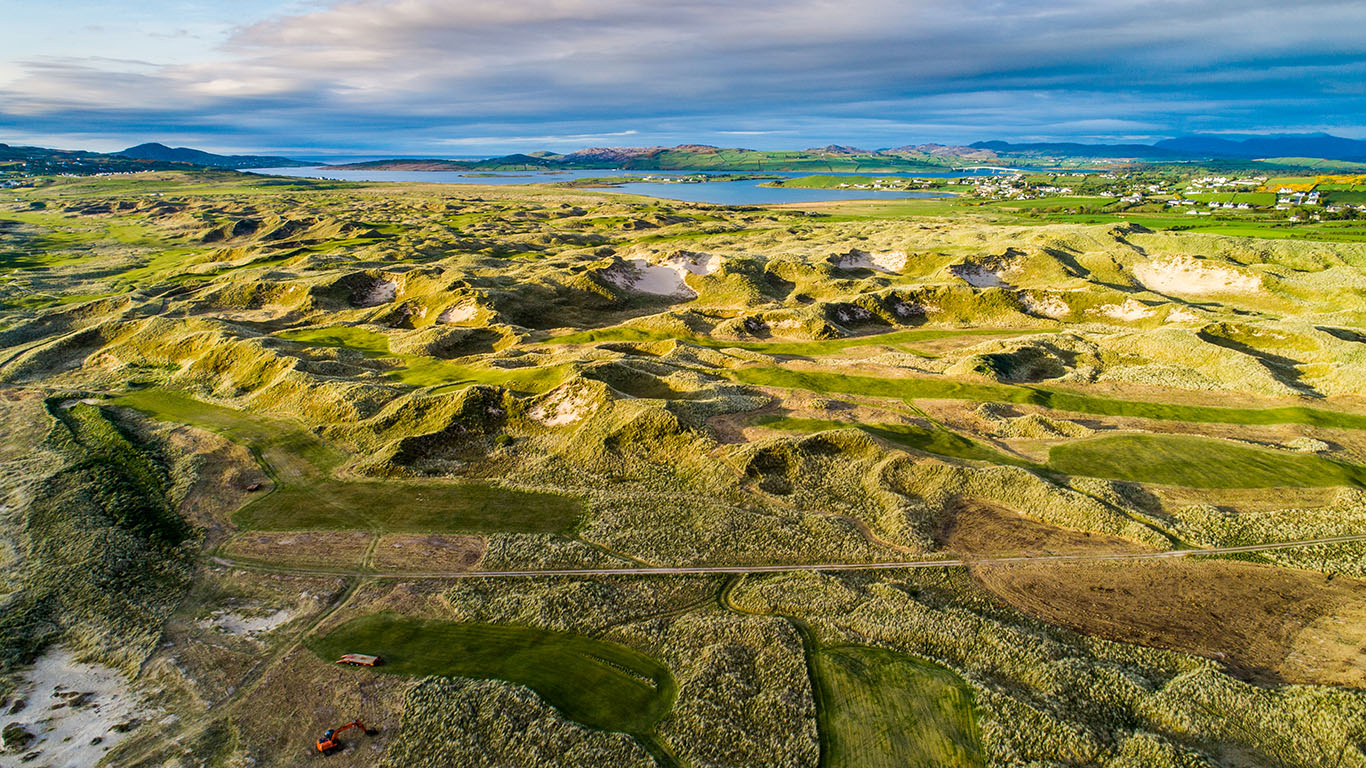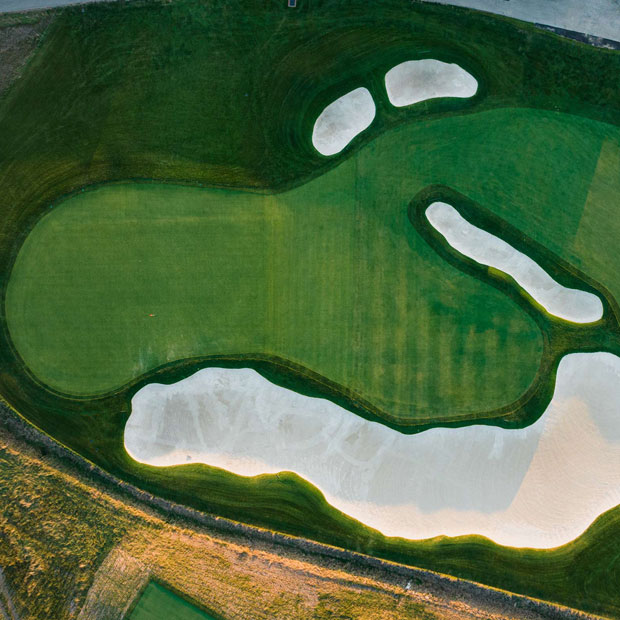What to Know About Sand Scrapes
The Open rota’s hottest new design trend is… exposing sand! (And it’s not always great.)


The latest buzzword in golf architecture is “sand scrape.” Recently, Royal Liverpool installed several sand scrapes in its primary dune ridge, and they were on display at this past week’s Open Championship. In my opinion, they didn’t look very good. I wasn’t alone in my assessment. As the sand-scrape discourse developed, we received many questions on the topic from readers and listeners. I’ll address a few here:
What are sand scrapes?
They are natural—or naturalized—areas of exposed sand. In the U.S., they’re commonly called “waste bunkers” or “waste areas,” sometimes “blowouts.” They occur naturally in linksland and other sandy, undulating environments, and in some cases are formed by rabbits and other burrowing animals. Once sand scrapes open up, they tend to shift in size and appearance, especially in windy places like the seaside links of Great Britain and Ireland. As linksland matures and stabilizes under human influence, exposed sandy areas often shrink and become overtaken by turf.
Sand scrapes were among the first and most important golf hazards, featuring prominently on early Scottish courses. Over time, they became formalized into bunkers with sod walls.
How are sand scrapes built on sandy sites?
By scooping, cleaning, and shaping, basically. UK-based architect Clyde Johnson, who has worked on numerous projects for Tom Doak’s Renaissance Golf Design (and written for The Fried Egg), took me through how he helped create sand scrapes at St. Patrick’s Links in Ireland.
“We’d just scoop the marram [dune grass] up in blocks with the excavator, using a specially fabricated bucket with long forks on the end,” Johnson wrote. “Often we would clean the floors of any darker sand/leftover organic material to discourage weeds from coming back. Once the bulk of the marram/organic was out, we’d go back in and tear away the edges of the waste area to give an aged look. Sometimes we’d leave strips/chunks of marram to appear as if the wind had eroded the edge.”

Sand scrapes at St. Patrick's Links (AirSwing Media)
This process varies from site to site (the St. Patrick’s property, for instance, had many natural sand scrapes that the crew used for reference), but Johnson’s description gives the basic idea.
On which golf courses can sand scrapes be found?
A bunch. In the U.S., you can find mixtures of natural and artificial sand scrapes at many high-profile and well-regarded courses, including Pine Valley, Sand Hills, Friar’s Head, Seminole, and destination-golf resorts like Bandon Dunes, Sand Valley, and Streamsong. The sandy waste area has become an aesthetic signature, perhaps even a cliché, of modern American golf architecture.
In the past 15 years or so, the trend has spread to Great Britain and Ireland. Many well-known courses, including several Open Championship hosts, have installed sand scrapes recently. At Royal Liverpool, for instance, there are large new exposed areas behind the 12th green, along the left sides of the 13th and 14th holes, throughout the freshly conceived par-3 17th hole, and in front of the seventh tee. Most of these are out of play, and none is intended to have a particular effect on a player’s strategy.
Why are sand scrapes being manufactured at Royal Liverpool and other sand-based golf courses in Great Britain and Ireland?
Exposed sand offers a number of potential advantages for golf courses:
1. It can replace maintained rough, allowing greenkeepers to dispense with invasive and undesirable grasses and to reduce water and chemical usage. Tom Coulson—the course manager at Seaton Carew Golf Club, a seaside links in England—gives an informed perspective on this issue here.
2. It can, as it has at Royal Liverpool, provide a cost-effective source of topdressing material.
3. It can serve as a habitat for certain animals, especially insects and lizards, driven out by the encroachment of golf turf on formerly sandy terrain.
4. It can have historical resonance, as many links courses featured more sand scrapes before increased play, modern agronomy, and natural site maturation either tamed or eradicated them.
5. In Great Britain and Northern Ireland, it can be part of an overall ecological-management program that satisfies the strict demands of UK environmental law. As Jon Wall, a UK-born superintendent who now works at Shanqin Bay in China, put it on Twitter, “Any work undertaken must improve and secure the long term survival of the local ecology or a specific habitat. There’s a higher premium placed on the site’s function, rather than solely on its form.”
6. It can help courses obtain funding from UK government agencies like Natural England.
7. Some believe it simply looks better than plain rough or native grasses.
Another reason for the proliferation of sand scrapes at courses in GB&I is that a popular architecture firm is fond of building them.
Who?
Mackenzie & Ebert. Since its founding in 2005, this firm, consisting of design partners Tom Mackenzie and Martin Ebert, has won a remarkable number of renovation commissions. The two principals work separately on jobs—for instance, in recent years, Mackenzie has overseen changes at Royal Birkdale and Royal Dornoch, while Ebert has directed projects at Trump Turnberry, Royal Portrush, and Royal Liverpool—but they typically receive joint credit. The scrapes at Royal Liverpool have been advertised as the work of
“Mackenzie & Ebert,” as have the ones at next year’s Open venue Royal Troon, 2021 Open venue Royal St. George’s, and 2019 Open venue Royal Portrush. See a theme? Exposed sand at Open Championship courses has become M&E’s calling card.
The only Open-rota courses where the firm doesn’t (yet) consult are Muirfield and the Old Course at St. Andrews. Clearly, Mackenzie & Ebert have a close relationship with the R&A, the governing body that runs the Open, the Women’s Open, and a series of prestigious amateur tournaments in Great Britain and Ireland. Ebert is an R&A member who has served on the Open championships committee, the amateur championships committee, and the rules committee. The firm’s influence at R&A championship venues isn’t likely to fade anytime soon.
Why are some architecture geeks—including you, Garrett—criticizing the sand scrapes that Mackenzie & Ebert have created?
I don’t object to artificial sand scrapes in general. When executed proficiently on suitable terrain, they can provide both ecological benefits and visual pop. They also work well as hazards: intimidating and challenging, yet usually playable.
My concerns with Mackenzie & Ebert’s sand scrapes center on execution. To my eye, many of them don’t blend visually with their environments. For example, the sandy areas on two of Mackenzie & Ebert’s showpiece par 3s—No. 17 at Royal Liverpool and No. 5 on the Himalayas nine at Prince’s, both new holes—have frilly fingers that seem too neat and regular to have occurred naturally.
{{content-block-what-to-know-about-sand-scrapes-001}}
Ancient linksland sand scrapes were less fussy and more chaotic—big gouges in the land with random incursions of native grasses. They didn’t have pretty little edges; they were blunt and raw.
Vast areas of exposed sand a century ago at Prestwick and St Andrews. I'd guess the bunkers would have been changed every year with storms pic.twitter.com/0qyyT9OXal
— Simon Haines (@Hainesy76) November 25, 2016
Also, each site yields its own type of sand scrape. Much depends on wind, topography, grass types, and local animals. Mackenzie & Ebert’s sand scrapes, however, are broadly similar from course to course. On properties as different as Hoylake, Turnberry, Troon, Hillside, Hollinwell, and Prince’s, the firm’s work adopts more or less the same scale and style.
{{content-block-what-to-know-about-sand-scrapes-002}}
These changes appear to be a homogenizing force, attenuating each course’s specific sense of place in favor of fashion.
Of course, all of this is a matter of aesthetic judgment, which is largely subjective. There are many people, including members and greenkeepers at the clubs in question, who like the new sand scrapes, or at least don’t see a problem with them.
Moreover, the scrapes will change with time and weather, like all landforms on links courses. Perhaps they will eventually settle in and start to look more like natural burrows and blowouts. “It’s worth noting,” Clyde Johnson told me, “that these things will evolve over time and re-naturalize. Culturally, I don’t think there is the same expectation [in GB&I] that golf courses are fixed in one perfect moment in time. They are seen as more organic, living things—just a place to play the game.”
So maybe some patience is warranted.
At the same time, many of today’s leading golf architects are able to produce sand scrapes that look good right out of the box. As the R&A’s preferred design firm, tasked with improving some of the world’s oldest and best courses, Mackenzie & Ebert should meet the same standard.
Leave a comment or start a discussion
Engage in our content with thousands of other Fried Egg Golf Members
Engage in our content with thousands of other Fried Egg Golf Members
Get full access to exclusive benefits from Fried Egg Golf
- Member-only content
- Community discussions forums
- Member-only experiences and early access to events






.webp)





Leave a comment or start a discussion
Lorem ipsum dolor sit amet, consectetur adipiscing elit. Suspendisse varius enim in eros elementum tristique. Duis cursus, mi quis viverra ornare, eros dolor interdum nulla, ut commodo diam libero vitae erat. Aenean faucibus nibh et justo cursus id rutrum lorem imperdiet. Nunc ut sem vitae risus tristique posuere. uis cursus, mi quis viverra ornare, eros dolor interdum nulla, ut commodo diam libero vitae erat. Aenean faucibus nibh et justo cursus id rutrum lorem imperdiet. Nunc ut sem vitae risus tristique posuere.